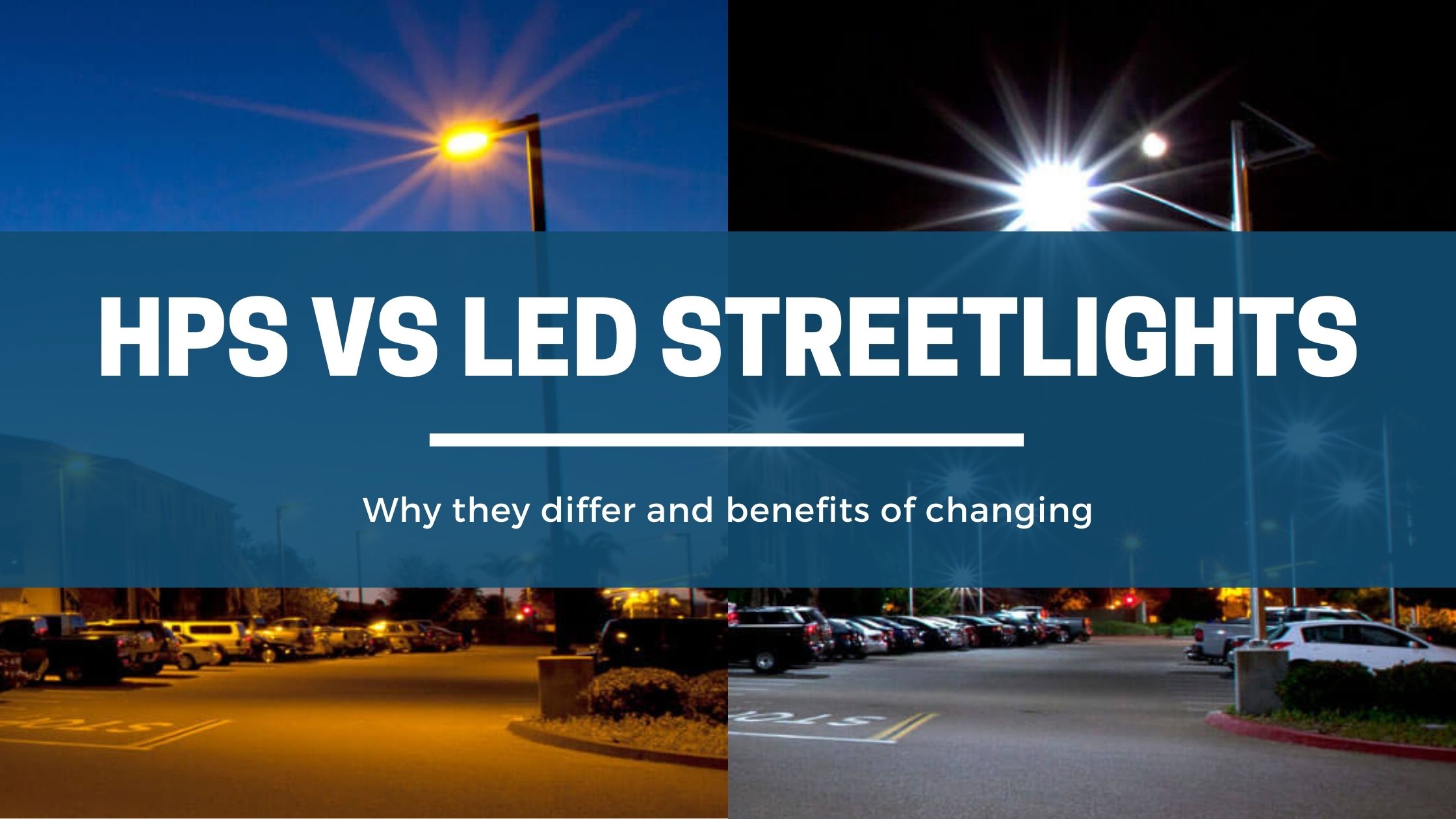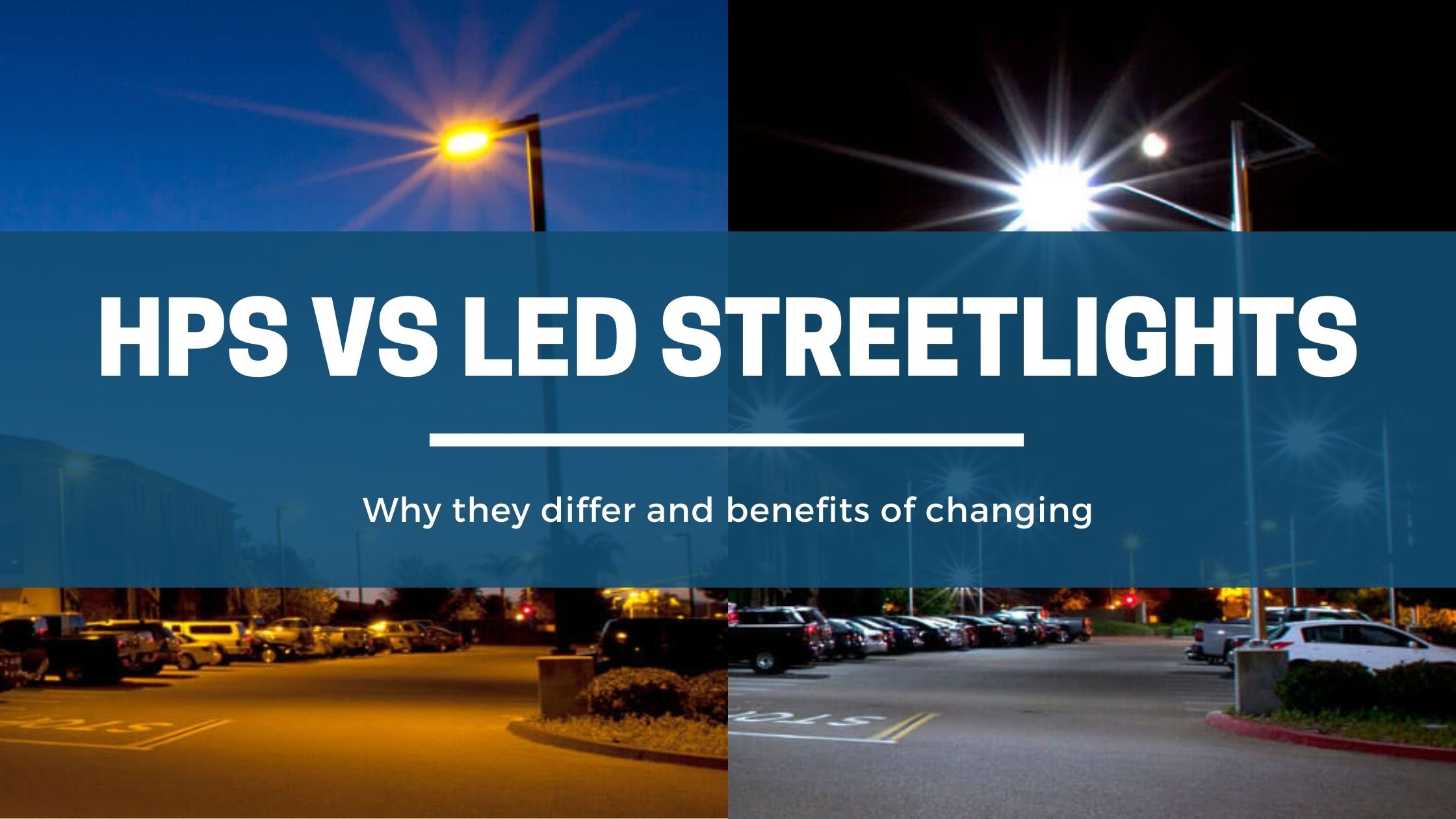



Cities and municipalities are phasing out HPS fixtures and switching over to more efficient LED fixtures for many reasons. There is a significant difference between these two setups. Not only do LED fixtures provide better lighting with a much lower power requirement, but LEDs also save money with maintenance costs and can more easily use motion-sensing technology. Here is a review of the two technologies and the variations between them.
HPS and LEDs have around the same Lumen per Watt efficiencies in the field, around 100 LpW, but LEDs have begun to surpass that over the last couple of years and get closer to 130-150 LpW now. There is a big difference between the two, though.
HPS lamps are round and produce light in a 360° area, shining in all directions. On the other hand, LEDs shine light only in one direction, which means that the light is wasted without using a reflective surface that wasn’t shining directly out of the fixtures. The light is also only directed with reflectors and refractors, making the distribution of the fixture more difficult for task-specific lighting.
LEDs have many different distribution patterns available by using optical systems. If illuminating a pathway or a parking lot, the engineering firm would use different distribution patterns depending on the area of coverage required. Having light fixtures that work in such a manner allows for task-specific lighting and less light, and therefore, energy waste.
HPS lamps have a much shorter lifespan than LEDs. A typical HPS lamp lasts around 24K hours, whereas an LED light can last upwards of 200K hours.
Both HPS and LEDs keep a good amount of the original light output during their lifespan; LEDs do a bit better than HPS lamps; however, they are comparable.
Finally, something I haven’t seen much talk about online is the ballast lifespan. HPS lamps require the use of a ballast system, whereas LEDs are on a circuit board and utilize a driver. Ballasts have a lifespan of around 20-60K hours, where an LED driver can last 100K hours, meaning that the driver can last as long as the LEDs themselves.
HPS lamps and ballasts have a much lower cost for purchase; however, their lower lifespan creates a much higher maintenance cost. The added maintenance makes a much higher cost over the life of a fixture. Maintenance even goes up more in extreme temperature areas, such as hotter climates, lowering the lifespan of the already short life of HPS lamps.
Instead, LEDs have a much higher cost for the initial purchase. With only maintenance required once every 20 years or so, the overall cost of operation is much less. Because of this long lifespan, the fixtures are made more sturdy and have a more extended warranty.
Cities and municipalities are starting to see these costs shift over the last 10 years or so and are starting to implement replacing old-style lights with newer LED fixtures as needed. This change will provide a great ROI and help the cities save money to reinvest in other areas needing upgrades.
LEDs are instant on and do not take time to warm up and get maximum light output. HPS lamps take time to produce their full light output, meaning they are not very good for use with motion sensors.
Cities and municipalities use motion sensors when security and visibility are essential, and power consumption needs to be lower. By benefiting from the instant-on capabilities of LEDs, motion-sensing can work well, allowing the fixture to either operate at a reduced output or from completely off to on. The fixture can go from completely off to full output in a second, ensuring the safety of the complete visibility of the people in the area.
Visibility is an important topic to cover when it comes to the lighting industry. The color of the light changes how our eyes perceive our environments. By using light closer to the light produced by the sun dramatically improves visibility. LEDs are available in 2700K-6500K and a CRI of 70-80.
HPS lamps have improved over the last couple of years but still don’t come close to what LEDs produce. The color output of an HPS lamp is 1900-2800K and has a CRI of 20-80. This color is more orange and doesn’t allow the eyes to differentiate between colors and shades of objects.
Not being able to see appropriately doesn’t allow the human eye to register the information that it sees well, lowering safety and security and inhibiting security and law enforcement from doing their jobs properly. Having a light that allows the human eye to see correctly increases safety and ensures no confusion between one object and another.
Solar and LEDs go hand in hand. The lower power requirement of LEDs to produce more and better light for task-specific lighting allows solar to be used for most applications, providing a green alternative to traditional lighting projects.
The popularity to use motion-sensing adds another step down in power requirements, allowing for either smaller solar power assemblies to be used or allowing for much higher wattages when motion is detected. This change allows for solar lighting systems to become more competitive and provide more applications where solar can take the place of grid-tied lighting systems.
HPS lamps are slowly phasing out on new installations with the implementation of LEDs on the market. Cities and municipalities are seeing these long-term benefits outweigh the short-term savings of staying with the older technology. Solar lighting system manufacturers can see the improvements of these changes affecting the solar lighting market by allowing more installations to occur since solar lights can reach the same light levels as old-style lamping options.
Now that solar is becoming even more competitive and the availability of tax incentives and other state and local government incentives, there is an uptick in solar street lighting projects. This increase will only allow for more innovation and advancements on the market, allowing solar lighting systems to become even more competitive with traditional grid lights. Maybe one day soon, we can see the world covered in solar lighting systems.
